The Davies Mansion–the genealogy of a house
This is the beginning of a long story. It involves the history of a house, several families, a culinary school and a university and it has become the obsession of this genealogist. This story has it all, a family flush with new wealth created in the age of the Industrial Revolution, servants just arrived from Ireland or the southern states, labor history, illness, family lawsuits, religious strife, conflict between town and gown, fact, fiction, rumor and innuendo. I begin where it all began for me.
The House

393 Prospect Street. When I arrived in New Haven in the late 70’s Prospect Street was a lovely neighborhood with a few big old houses and some university buildings. The remaining old buildings were being purchased by Yale University as they became available. And there on the top of Prospect Hill surrounded by a large expanse of weedy empty space was a big, beautiful old house, 393 Prospect Street. When I asked about it, everyone knew it was the Davies Mansion; no one knew anything about it. It will come as no shock to anyone who knows me or anyone who reads my pieces in this blog that I had to find out. First, the facts about the early years.
In 1867 John M Davies, a wealthy industrialist, a manufacturer of men’s furnishings, commissioned Henry Austin, a well-known Victorian architect, to build a grand house for himself and his family in the finest part of town. Austin was responsible for many of New Haven’s finest buildings and when this one was completed it would be the city’s largest home with an interior of 19,000 square feet, 23 rooms, and seven acres of lawns and gardens. Once it was surrounded by the mansions of Eli Whitney, Oliver Winchester, and other wealthy manufacturers, today it is the only one of the grand mansions still standing. John Davies lived in the house for a few brief years before he died in 1871. His widow Alice lived on in the house until her death in 1898. I’m not sure who lived in the house between 1898 and 1911, but in 1911 the house was sold to Thomas Wallace. Wallace was the owner of Wallace and Sons, a prosperous wire manufacturing company in nearby Ansonia. He lived in the house on Prospect Street with his family until his death in 1946. In 1947 the house was sold to the Culinary Institute of America.
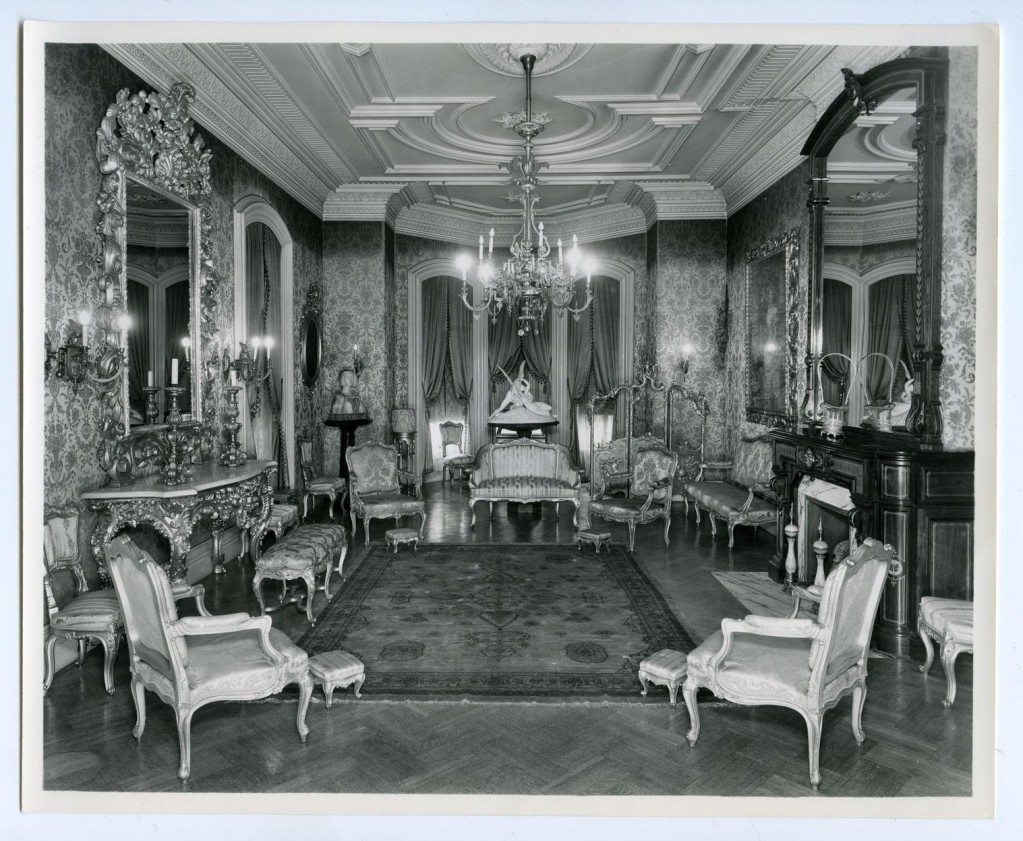
- The Drawing Room
photos courtesy of the Culinary institute of America
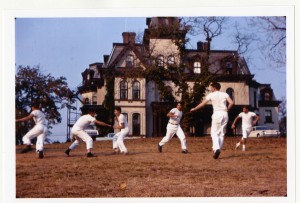
- Culinary students taking a break
The Culinary Institute of America is now located in Hyde Park, NY and is the premier culinary institution of this country. In 1947 it was known as the Restaurant Institute of Connecticut. Although common place now, this was the first culinary school in America. I love food. I love to cook; I love to eat ; I love to look at food. I can’t resist a brief aside here.
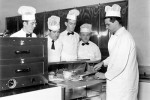
The 1950’s was an interesting time for American cuisine; one of its admirable goals was to free American housewives from their daily grind, with labor saving devices and quick to prepare foods. This was the time when the idea was floated that one day we could just swallow a pill for dinner and have all our nutritional needs satisfied. Foodies like myself consider the 50’s to be the long, dark night of the soul for American cooking. The Culinary Institute was one of a few places that kept the idea of American cuisine alive until we came to our senses.
At any rate the house was converted to a school. Yes, the interior changed, but the basic structure was well maintained. From the outside the house looked as it had since 1868. The Restaurant Institute became the Culinary Institute of America causing a few double takes as students walked around New have in sweatshirts with CIA emblazoned on the front. And so it went until the Culinary Institute of America outgrew its New Haven home and moved to Hyde Park. Yale University bought the property in 1972.
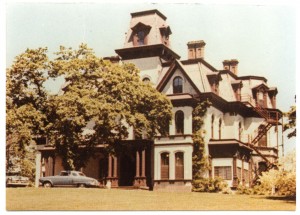
And here the story of neglect and claims and counterclaims, movie offers and refusals and ultimately redemption begins. Yale purchased the house and the land surrounding it with the intention of making use of empty land in an area that was rapidly being built up with university properties. What is fact is that Yale did little maintenance on the house after its purchase, using it as a storage building. Yale moved to demolish the house in 1980 and preservationists fought against the move. Local rumor says there are firefighters from that time who say they were told to simply let the building go if there was a fire.
In 1980 the university announced plans to tear the house down and the building became something of a cause celebre among Yale students. The Yale Ad Hoc Committee to save the Davies House printed bumper stickers that changed Yale’s motto from “For God, for country, and for Yale” to ” For God, for country, and for the Davies Mansion”. 200 people rallied in front of the secretary’s office just before Yale’s announced demolition date of March 31, 1980. The group included representatives of the Connecticut Trust for Historical Preservation, the State Historical Commission and the New Haven Preservation Trust. Just about everyone who cared about preservation was represented. At the last moment the deadline was extended, and in July of 1980 a development proposal was accepted.
The headline in the New Haven Register reads “Historic Davies house to be reborn as an inn”. Arthur Fisher, head of Fisher Associates put forth a proposal to open a lovely Victorian Inn, preserving the old house and recreating some of its former glory. The university accepted. Another headline in the Register reads, “Hunt on for treasures stripped from Davies”. Many things had gone missing, the fine mantel pieces, all kinds of wonderful architectural details, the hand carved banisters were all among the missing. Everyone accused everyone else, but no matter, things would be found or recreated and the inn would open its doors in 1981.
S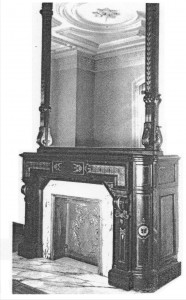 ix more years would pass. Again, the stories of what happened in those six years vary, but, finally, a lease was signed, the boards came off, and work began. Then Fisher ran out of money. But all was not lost, another development firm offered to take over the building with Yale’s approval. Yale refused. Apparently, to quote Marsha Ryan of the Yale real Estate Office, “Yale had a chance to reflect on how we wanted to use the building and decided to use it for academic purposes.” Work would begin shortly to prepare the building for academic use.
ix more years would pass. Again, the stories of what happened in those six years vary, but, finally, a lease was signed, the boards came off, and work began. Then Fisher ran out of money. But all was not lost, another development firm offered to take over the building with Yale’s approval. Yale refused. Apparently, to quote Marsha Ryan of the Yale real Estate Office, “Yale had a chance to reflect on how we wanted to use the building and decided to use it for academic purposes.” Work would begin shortly to prepare the building for academic use.
More years passed. Then in 1990 two things happened. There was a fire that caused considerable damage to the house and in the next bizarre twist in the saga the old place was apparently creepy and kooky enough that the producers of the Addams Family movie thought it was the perfect house for Gomez and Morticia. An offer was made to use the property and restore it, which the university refused. This was taken as proof positive by some that the university had no intention of saving the mansion. University spokesmen said the university was concerned about all the disruption involved in a Hollywood production. Whatever the truth of all this, eight more years passed. Finally in 1998 an agreement was reached between Yale and the preservationists to preserve four historic buildings including the Davies Mansion. The exterior of the mansion was restored by 2000. In 2001 Yale alumni Roland Betts donated five million dollars toward the renovation of the Davies Mansion. The renovation cost about fourteen million dollars before its completion in 2002.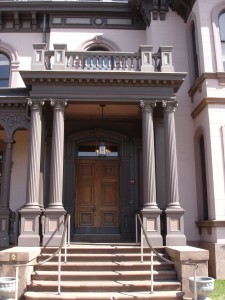
The good news, really great news, is that once the university decided to restore the place they decided to do it right. The first floor has been returned to its nineteenth century glory. The fourteen-foot high ceilings and spacious rooms have been preserved; original moldings, window frames and mantels have been preserved or replaced. The beautiful grand staircase greets visitors once again. Colors and flooring are true to the original house. The second and third floors are more modern in their design. The building now renamed the Betts House serves as the Center for Globalization, providing a home and meeting space for visiting scholars from all over the world.
In 2009 the Maurice Greenberg Conference Center was added to the grounds and attached to the house. Of course, there are a variety of opinions on this. It would be lovely if the old place still stood alone, preserved as a museum of days past, but that was never a possibility. Personally, I think it is a good compromise both meeting the needs of the university and preserving the house for future generations.
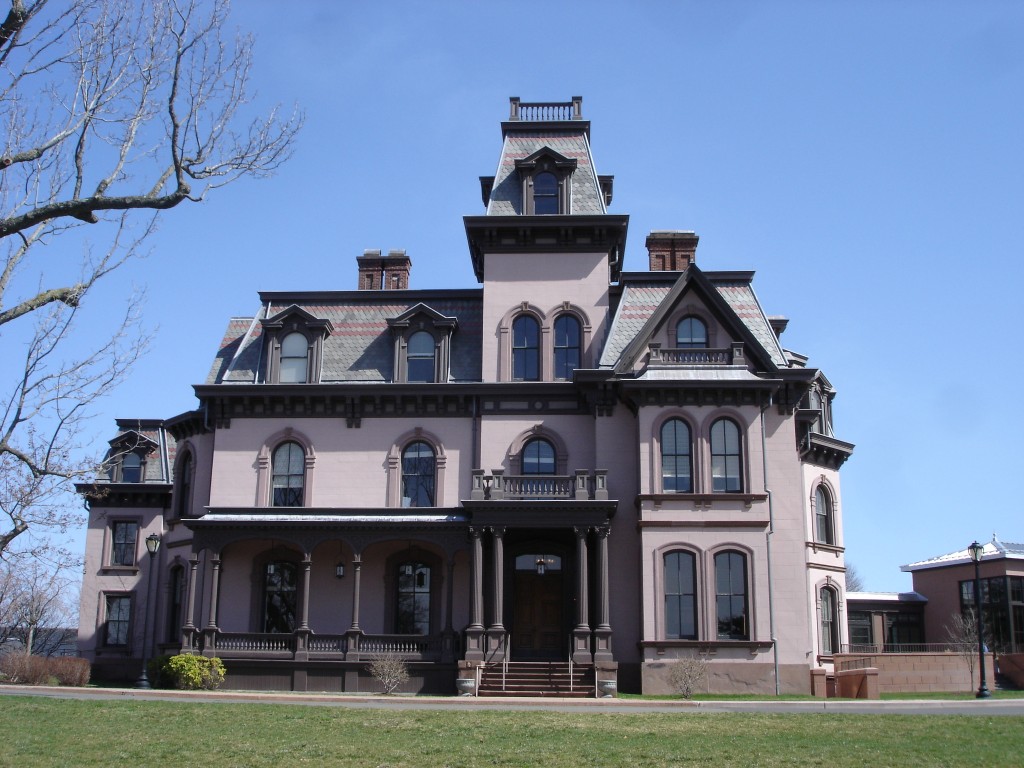
This is the end of the story of the physical structure, at least for the moment, but families lived and died and loved and fought in that house. Their stories will follow in a few weeks or months and they are even more interesting than the story of the house.

Just to follow-up on this portion of the story…”in 1911 the house was sold to Thomas Wallace. Wallace was the owner of Wallace and Sons, a prosperous wire manufacturing company in nearby Ansonia. He lived in the house on Prospect Street with his family until his death in 1946.”
I recently wrote about Thomas Wallace and his family who also lived in Woodbridge — you can read more about him and his family here (he is Thomas H. Wallace III, born1860 died1947): http://www.townhistory.org/elderslie/
Wonderful history lesson — looking forward to the future installments! (I work at Yale and my office is in this building.) By the way, John Davies is buried in Evergreen Cemetery — his memorial is available online here:
https://www.findagrave.com/memorial/147372730/john-may-davies
Wonderful history lesson — looking forward to the future installments! (I work at Yale and my office is in this building.)
Thanks for sharing the story of this magnificent house. I’ve parked in that driveway staring at that old mansion many times since I first saw the place. I’d sit there daydreaming of a lotto win that would allow me to live in a place like that. I’m really glad the evil New Haven billionaire Yale University didn’t get away with tearing it down, or destroying a beautiful piece of New Haven’s history. They’ve bought up and destroyed enough of New Haven’s landscape, and filled it with some really ugly buildings. Too bad they didn’t allow the Addams Family movie to use the house. Would have been awesome to be able to see the inside of the house, and have it documented on film. It would be awesome if the building was opened up to tours, or a documentary be made showing how wealthy industrialists lived during the 1800s.
There’s another beautiful old Victorian mansion up in the Fair Haven Heights area, just off Grand Avenue (East). Not near as large as the Davies/Betts mansion but definitely interesting, in it’s own right. Do you happen to know anything about that house?
Would have been great if they hadn’t demolished Winchester’s home next door. That too was a masterpiece. And Davies and Winchester were close partners.
Iam glad yale didnt demolished this house it alook back at history i would love to see the interior of the house
I love this house iam glad yale didnt demolish it i would love love to see the interior of the house
I’m glad Yale restored it but they shouldn’t have built the connected building they should have just did the Davies house.
Thanks Michelle. I hope the next installment is done in this decade.
Judy
This is a really interesting story. I’m looking forward to the next installment.
Thanks Joan,
I’m beginning to think of this story as a life’s work, and now I’ve pulled pat into it.
Judy
A great beginning! Looking forward to the stories to follow.